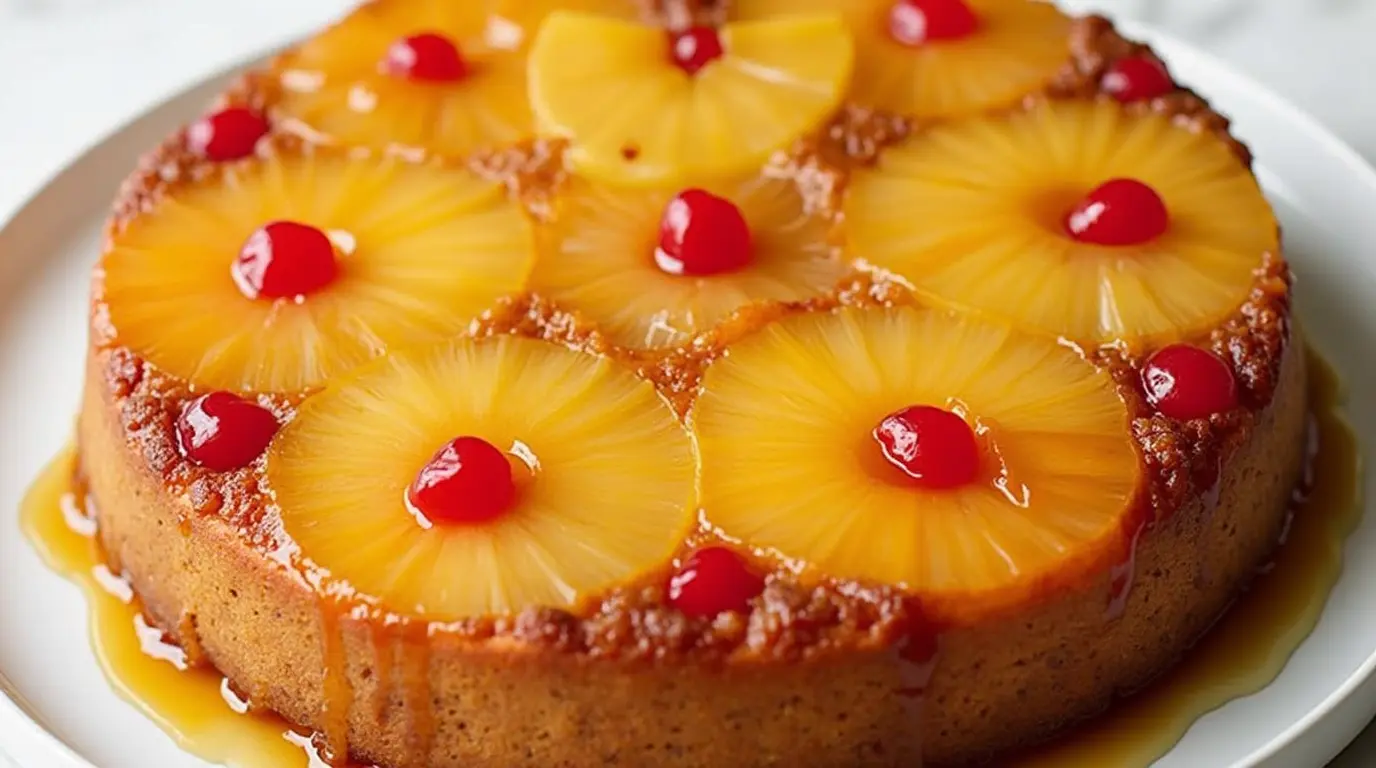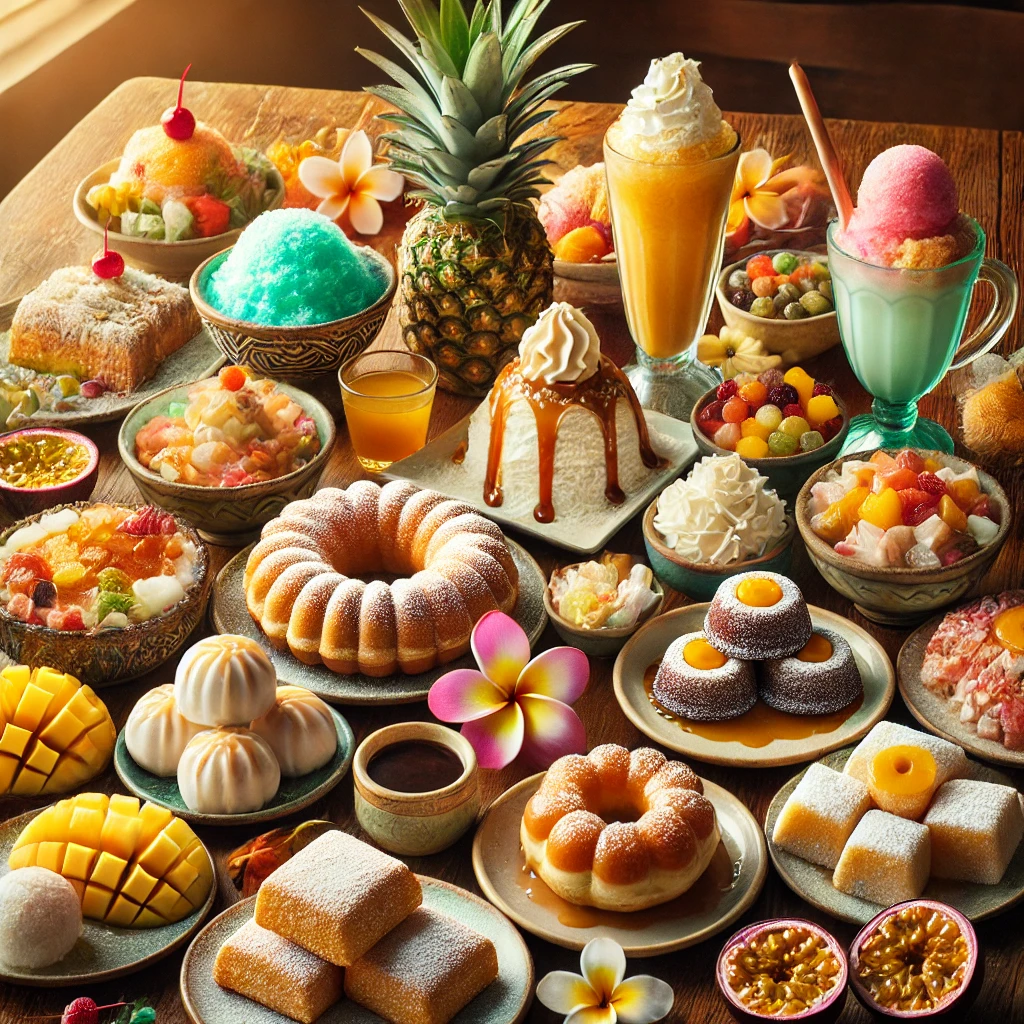Hawaiian desserts are a delightful blend of tropical flavors and rich traditions, bringing a taste of paradise to your kitchen. These sweet treats often feature ingredients like coconut, pineapple, and passion fruit, offering a unique and refreshing twist on classic desserts.
Table of contents
Introduction to Hawaiian Desserts
The Flavors of Hawaii
Hawaiian desserts are known for their vibrant and exotic flavors. Tropical fruits like pineapple, mango, and lilikoi (passion fruit) are staples, providing a natural sweetness and tartness that complement the creamy and rich elements of these desserts. Coconut, another essential ingredient, adds a distinctive nutty flavor and texture, often used in various forms such as milk, cream, or flakes.
Why You’ll Love These Desserts
There’s something incredibly inviting about the freshness and simplicity of Hawaiian desserts. They are not only delicious but also relatively easy to make, often requiring just a few ingredients. These desserts are perfect for any occasion, from family gatherings to casual dinners, and their vibrant colors and flavors are sure to brighten up any table.
Essential Ingredients
Tropical Fruits
Tropical fruits are the heart and soul of many Hawaiian desserts. Fruits like pineapple, mango, papaya, and lilikoi (passion fruit) bring a burst of natural sweetness and vibrant color to these dishes. They are often used fresh, pureed, or in the form of juices to add a distinctive tropical flair.
Local Sweeteners
Hawaiian desserts frequently incorporate local sweeteners like coconut sugar and honey. These natural sweeteners provide a rich, caramel-like flavor that enhances the overall taste of the desserts. Coconut sugar, in particular, adds a subtle nutty taste that pairs well with tropical fruits.
Other Key Ingredients
Other essential ingredients in Hawaiian desserts include coconut milk, macadamia nuts, and taro. Coconut milk and cream add a creamy texture and a mild coconut flavor. Macadamia nuts bring a delightful crunch and buttery taste, often used as toppings or mix-ins. Taro, a starchy root vegetable, is used in traditional desserts like poi and haupia, offering a unique taste and texture.
Recipe: Pineapple Upside-Down Cake

Ingredients
– For the Topping:
- 1/4 cup of unsalted butter, melted
- 1/2 cup of packed brown sugar
- 1 can (20 oz) of pineapple slices, drained
- Maraschino cherries
– For the Cake Batter:
- 1 and 1/2 cups of all-purpose flour
- 1 cup of granulated sugar
- 1/3 cup of unsalted butter, softened
- 1 and 1/2 teaspoons of baking powder
- 1/2 teaspoon of salt
- 2 large eggs
- 1 teaspoon of vanilla extract
- 1/2 cup of pineapple juice (reserved from the can)
- 1/2 cup of milk
Instructions
– Preparing the Topping
- Preheat the Oven: Preheat your oven to 350°F (175°C).
- Prepare the Pan: Pour the melted butter into a 9-inch round cake pan, tilting to coat the bottom evenly.
- Add Brown Sugar: Sprinkle the brown sugar over the melted butter, spreading it out evenly.
- Arrange Pineapple and Cherries: Arrange the pineapple slices on top of the brown sugar in a single layer. Place a maraschino cherry in the center of each pineapple slice.
– Making the Batter
- Cream Butter and Sugar: In a large mixing bowl, cream the softened butter and granulated sugar together until light and fluffy.
- Add Eggs and Vanilla: Add the eggs one at a time, beating well after each addition. Stir in the vanilla extract.
- Combine Dry Ingredients: In a separate bowl, combine the flour, baking powder, and salt.
- Mix Batter: Gradually add the flour mixture to the butter mixture, alternating with the pineapple juice and milk. Begin and end with the flour mixture, mixing until just combined.
– Baking the Cake
- Pour Batter: Pour the batter evenly over the pineapple slices in the cake pan.
- Bake: Bake in the preheated oven for 40-45 minutes, or until a toothpick inserted into the center of the cake comes out clean.
- Cool the Cake: Remove the cake from the oven and let it cool in the pan for 5 minutes.
- Invert the Cake: Run a knife around the edges of the pan to loosen the cake, then invert it onto a serving plate. Allow the pan to sit over the cake for a few minutes to let the brown sugar mixture drip over the cake.
- Serve: Serve the Pineapple Upside-Down Cake warm or at room temperature. Enjoy a slice of Hawaiian paradise!
Recipe Variations
Adding a Hawaiian Twist
– Using Different Fruits
While the classic Pineapple Upside-Down Cake is delicious, you can experiment by adding other tropical fruits. Consider using mango slices, papaya, or even a combination of pineapple and banana. These fruits will bring different textures and flavors, making the cake uniquely delightful.
– Experimenting with Flavors
To enhance the Hawaiian flair, you can add a splash of coconut milk to the cake batter or sprinkle shredded coconut on top before baking. Another option is to incorporate a hint of macadamia nuts for added crunch and a nutty flavor. These variations can elevate your dessert and surprise your taste buds.
Making It Healthier
– Substituting Ingredients
If you want a healthier version of the Pineapple Upside-Down Cake, consider substituting some ingredients. Use whole wheat flour instead of all-purpose flour, and replace granulated sugar with coconut sugar or a natural sweetener like honey or maple syrup. These swaps will make the dessert a bit lighter while maintaining its delicious taste.
– Reducing Sugar Content
You can reduce the overall sugar content in the recipe by cutting the amount of brown sugar used in the topping and using fresh pineapple slices instead of canned ones. Fresh pineapple is naturally sweet and will reduce the need for added sugars, making the dessert more wholesome.
Cultural Significance
History of Hawaiian Desserts
– Traditional Ingredients
Hawaiian desserts have a rich history, influenced by the islands’ diverse cultures and abundant natural resources. Traditional ingredients like coconut, taro, and tropical fruits have been staples in Hawaiian cuisine for centuries. These ingredients were not only readily available but also deeply rooted in the islands’ agricultural practices and cultural rituals.
– Evolution Over Time
Over time, Hawaiian desserts have evolved, incorporating influences from various cultures, including Japanese, Filipino, and Portuguese cuisines. This fusion has led to the creation of unique desserts that reflect the multicultural heritage of Hawaii. For example, the popular Malasadas (Portuguese doughnuts) were introduced by Portuguese immigrants and have become a beloved treat in Hawaii.
Celebrations and Festivals
– Hawaiian Luau
The Hawaiian luau is a traditional feast that often features a variety of delicious desserts. Luaus are a celebration of Hawaiian culture, complete with hula dancing, music, and a lavish spread of food. Desserts like Haupia (coconut pudding) and Lilikoi (passion fruit) cheesecake are commonly served, offering guests a taste of the islands’ sweet traditions.
– Dessert Traditions
In addition to luaus, various Hawaiian festivals and celebrations showcase the islands’ diverse dessert offerings. Events like the Honolulu Festival and the Maui Agricultural Festival highlight local delicacies, including traditional and contemporary Hawaiian desserts. These celebrations not only provide an opportunity to enjoy delicious treats but also to learn about the cultural significance behind them.
Storing and Serving
Storing Your Dessert
– Short-Term Storage
For short-term storage, the Pineapple Upside-Down Cake can be kept at room temperature for up to 2 days. Ensure it is covered with plastic wrap or stored in an airtight container to prevent it from drying out. If you prefer, you can refrigerate the cake for up to a week, which helps maintain its freshness.
– Long-Term Storage
For longer storage, you can freeze the Pineapple Upside-Down Cake. Wrap the cake tightly in plastic wrap and then in aluminum foil to protect it from freezer burn. It can be stored in the freezer for up to 3 months. When ready to enjoy, thaw the cake in the refrigerator overnight and bring it to room temperature before serving.
Serving Suggestions
Hawaiian desserts are often enjoyed chilled or at room temperature. For the Pineapple Upside-Down Cake, you can serve it warm or at room temperature. It pairs wonderfully with a scoop of vanilla ice cream or a dollop of whipped cream. For an extra tropical touch, garnish with additional fresh pineapple slices or a sprinkle of shredded coconut. This makes for a visually appealing and delicious presentation, perfect for any occasion.
Final Thoughts
Hawaiian desserts offer a unique and delightful taste of the tropics, blending exotic flavors and rich traditions. From the refreshing Pineapple Upside-Down Cake to other classic treats, these recipes are perfect for any occasion. They are not only delicious but also relatively easy to make, allowing you to bring a bit of Hawaiian paradise into your kitchen.
Frequently Asked Questions (FAQs)
How should I store leftovers of Pineapple Upside-Down Cake?
Store any leftover Pineapple Upside-Down Cake in an airtight container in the refrigerator. It will stay fresh for up to a week. If you prefer, you can also freeze the cake. Wrap it tightly in plastic wrap and then in aluminum foil before freezing. Thaw it in the refrigerator overnight before serving.
Can I make Pineapple Upside-Down Cake in advance?
Yes, you can make Pineapple Upside-Down Cake in advance. It’s actually a great dessert to prepare ahead of time. Bake the cake, allow it to cool completely, and then store it in the refrigerator. You can warm individual slices in the microwave for a few seconds before serving, if desired.
What should I do if my cake sticks to the pan?
If your cake sticks to the pan, try running a knife around the edges to loosen it. You can also place a hot, wet towel on the bottom of the pan for a few minutes to help release the cake. When inverting the cake onto a serving plate, gently tap the bottom of the pan to help it release.

